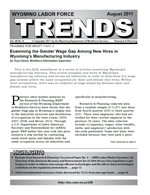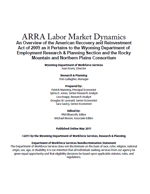
Occasional
Paper No. 5

- Introduction: Definition and Purpose of Labor Market Information and ARRA Grant of 2009
- Chapter 1. Definition(s) of "Green" Jobs
- Chapter 2. A Review of Alternative Energy and Environmental Enhancement Technologies
- Chapter 3. State Level Legislation Regarding Energy Efficient Technologies
- Chapter 4. Legislation and Regulatory Landscape Regarding Energy Efficient Technologies
- Chapter 5. Results of the Baseline Survey
- Chapter 6. A Summary of the New Hires Survey
- Chapter 7. Text Mining Analysis of the New Hires Survey
- Chapter 8. Wyoming IMPLAN Analysis of ARRA Spending
- Appendix A: Baseline Survey Cover Letter and Survey Instrument
- Appendix B: Brochure
- Appendix C: Survey Instrument
- Appendix D: Wyoming Community Colleges and University of Wyoming Environmental Programs of Study Offered
ARRA Dynamics in the Labor Market: Part 2
Editor's Note: Although traditional labor market research examines past patterns and market behavior to forecast trends, disturbances of differing magnitudes can alter these forecasts at the local, statewide, and national levels. Both the recent economic downturn and subsequent passage of the American Recovery and Reinvestment Act of 2009 (ARRA) are examples of such disturbances. To assess the effects of ARRA, the Research & Planning section of the Wyoming Department of Workforce Services, in cooperation with the Rocky Mountain and Northern Plains Consortium, received funding to study the workforce and, as a subset, jobs that spend time on activities that increase energy efficiency, use or develop renewable energy resources, or preserve or restore the environment.
The following three articles comprise the second part of a two-part series of excerpts from Occasional Paper No. 5 – ARRA Labor Market Dynamics: An Overview of the American Recovery and Reinvestment Act of 2009 as it Pertains to the Wyoming Department of Employment Research & Planning section and the Rocky Mountain and Northern Plains Consortium. Several other chapters of Occasional Paper No. 5 appeared as stand-alone articles in Wyoming Labor Force Trends (see related box).
A major component of this research was a survey of Wyoming employers who hired new workers from fourth quarter 2009 to third quarter 2010. This study showed segments of the labor market that were hiring despite the economic downturn, and to what extent these jobs involved energy-efficient activities: those "that produce goods or provide services that benefit the environment or conserve natural resources" or those "in which workers' duties involve making their establishments' production processes more environmentally friendly or use fewer natural resources."
The following first and second articles specifically address Wyoming's legislative and regulatory landscape in relation to energy-efficient technologies. The third article looks at employers' responses from the new hires survey using text mining to gain a clearer picture of which skills were deemed most important in those jobs.
- State Level Legislation Regarding Energy-Efficient Technologies
- Legislation and Regulatory Landscape Regarding Energy Efficient Technologies: Impacts on the Regulatory Environment
- Text Mining Analysis of the New Hires Survey
